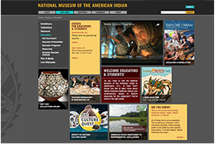
|
|
A Multitude of Media
|
|
The Smithsonian National Museum of the American Indian has a number of outstanding resources and learning opportunities for educators and students. One such learning tool is the Infinity of Nations Culture Quest, an online game that “offers us the opportunity to learn more about Native cultures through a collection of objects that tell their story.” Students navigate this resource by selecting one of ten regions in North, Central, and South America. Each section provides background on the region, its history, and its people. Interactive activities lead students through an analysis of the object, providing historical context and inviting students to make new understandings based on their observations. It's a fascinating way to learn about history and the experience leaves a lasting impression.
|

|

|
|
|
|

|
Matthew's Tip
of the Month
|
 May is National Asthma and Allergy Awareness Month. From the Asthma and Allergy Foundation of America (AAFA), “Asthma affects more than 24.5 million Americans. More than 6 million children under the age of 18 suffer from asthma. More than 50 million Americans have all types of allergies — pollen, skin, latex and more.” The TrueFlix Health category has units on both Asthma and Allergies, which each include lesson plans, online resources, project ideas, and more to support your units of study with students. It's also a wonderful chance for you to allow those students in your class who may have asthma or life-threatening allergies to share with the class how they handle their health and what things they'd like their classmates to know. May is National Asthma and Allergy Awareness Month. From the Asthma and Allergy Foundation of America (AAFA), “Asthma affects more than 24.5 million Americans. More than 6 million children under the age of 18 suffer from asthma. More than 50 million Americans have all types of allergies — pollen, skin, latex and more.” The TrueFlix Health category has units on both Asthma and Allergies, which each include lesson plans, online resources, project ideas, and more to support your units of study with students. It's also a wonderful chance for you to allow those students in your class who may have asthma or life-threatening allergies to share with the class how they handle their health and what things they'd like their classmates to know.
|
Matthew Winner
Library Media Specialist & TrueFlix Ambassador
|

|
|
|
|
|

|
|
|
Ignite your students' curiosity on a quest for learning by working with them to develop a series of well-constructed inquiry-based questions that can be used in self-guided research at a museum, a historical site, or by using an online resource such as TrueFlix. These questions can be used as entry points into their exploration of the history and culture of Native people and should leave students wanting to know more or to explore related topics. Here are some leading questions based on the different TrueFlix American Indians units:
-
In what ways did the California Gold Rush of the 1850's affect the Native people living in that region, including the Apache?
-
What was the significance of the Comanche “Code Talkers” to the success of the United States army in World War II?
-
What ways are archaeologists working with Native people today in order to respect and preserve history?
As a class, consider where students might visit digitally, virtually, or in person in order to pursue answers to their questions. Those students traveling this summer might consider asking their parents if a visit to a Native American Heritage Site or a museum with a Native American collection such as the National Museum of the American Indian or others listed here might be possible. Emphasize for students to document their research and discovery through photos, drawings, journals, audio recordings, or any other means. Recording information in any such way will help students to make a lasting connection with what they learn.
|
|
|
|
|

|
|
We'd Love to Hear From You!
|
|
Have a suggestion for what unit we should cover next? Or have an idea on how we can make this newsletter even better? Whatever it is, we're looking forward to hearing from you.
|

|
|
|
|

|
|
UPCOMING WEBINAR DATES
|
|
Learn more about getting the most out of TrueFlix by attending one of our monthly online training sessions.
|
Tuesday, May 9, 2017
12:00 to 1:00 pm EST
|

|
|
|
|
|
|

|
|
e-news Archive
|
|
Get more tips and tools from our past newsletters
|
|
|
|
|
|
|